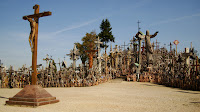 |
| Siaulai from Hotel Room |
Siaulai (pronounced shaulai) is a city in the centre-northern part of Lithuania, very close to Ryga, the capital of Latvia. While slowly walking to my hotel from the train station, my back breaking from the weight of my backpack, the first thing I noticed was the large number of youths in the city. I don't know why, but Siaulai gave me the feel of those suburban towns in the US where young guys huddle together over smokes or booze to talk big about how they're going to escape from town in their mother's car and never return. The city's only got one main pedestrian street where all the restaurants, cafes, bars and clubs are. There doesn't seem to be much beyond that. The only picture I took of the city was from my hotel room, on the top floor of the Siaulai Hotel - a soviet era concrete block of a building. Apparently it has recently been renovated, but the soviet spirit still remains. The rooms are comfortable, but austere and very functional; The furniture and paint are outdated and dull; at breakfast a hotel staff chases you around asking for you 'breakfast ticket!' But the hotel was such a welcoming sight after having stayed in a wooden cottage for two days - at last, wi-fi in my room and the facility to do laundry! By the way, the laundromat concept does not exist in Lithuania. All homes have washing machines. If not, then private companies will pick up dirty clothes from your home and return the lot on the same day or the next. If neither is available, well... Lithuania is rich with rivers. Seems I went off on a tangent... Ah, here's my old line of thought - so, why did I include Siaulai on my itinerary? Quite simply because of a very interesting sight called the 'Hill of Crosses.' Its title is self-explanatory: it is a hill covered with crosses. But it's the significance of the sight and how that significance changed over time that makes the place interesting.
 |
| Hill of Crosses |
It was a sunny day when I made my way to the Hill of Crosses. Rather than take the bus I decided I'd rent a bike and cycle all the way there (about 12 km). The city soon ended and gave way to green fields and tall trees. After about 45 minutes of cycling up and down hills, ingesting a few of those small flies that have nothing better to do but hover in the air on your cycling path, I finally made it to the sight. The hill stood near a winding river and tall trees. There was a gentle breeze blowing, the chime of metal crosses rang softly in the air. When I arrived there was a Polish congregation in front of the hill reciting something that sounded like a liturgy.
 |
| Hill of Crosses |
Although it isn't known exactly when the practice of planting these crosses first started and why on that particular hill, it is believed that people started out of religious reasons sometime during the 18th century. The political climate then changed: in the late 18th century Lithuania became part of the Russian empire. Lithuanians then started putting up crosses on the hill in remembrance of rebels who lost their lives fighting for independence. Independence was won, then lost to the Germans first during WWII then to the USSR in 1944. During Soviet occupation, from 1944-1990, Lithuanians planted crosses on the hill as a sign of their national identity and to protest against soviet occupation. The soviets bulldozed the sight a number of times, but Lithuanians kept on coming back to plant even more crosses.
 |
| Hill of Crosses |
According to Wikipedia the number of crosses was estimated at 55,000 in the year 1990. There probably are over hundreds of thousands of them by now. After walking up, down and around the hill I sat down on a nearby bench to eat lunch. A small number of tourists walked by me, mostly belonging to some tour. From their language I made out Germans, Russians, English and even a Japanese couple. It's like an open air church - they look at the hill in solemn admiration. This sight does not attract droves of tourist. The people that make their way there are usually on pilgrimage, to listen to the chime of crosses and remember.
No comments:
Post a Comment